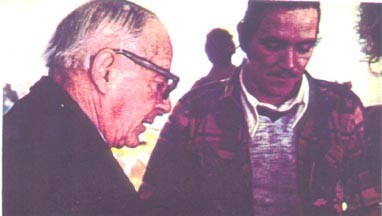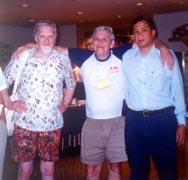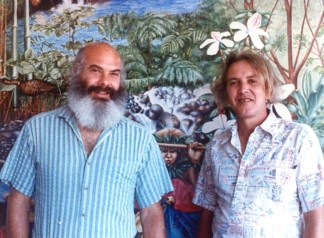Mushroom Pioneers
Chapter 8. Biographies of Other Mushroom Pioneers
Below are several dozen short biographies of some of those psilophorians whose interest in the sacred mushrooms goes far beyond that of their own minds.
Arno Adelaars #
graduated from the University of Amsterdam, is a Dutch freelance journalist and has published a fine book on European psilocybian mushrooms, "Alles Over Paddo's". Adelaars, together with Hans van den Hurk and Claudia Müller-Ebeling, were the organizers of the October 1998 "Psychoactivity" conference at the Tropen Museum in Amsterdam.Michael Aldrich #
is curator of the Fitz Hugh Ludlow Memorial Library and author of "The Dope Chronicles 1850-1950". Mr. Aldrich presides over the largest collection ever assembled of drug-related material from all over the world.John Marc Allegro #
was a British theologian and expert in ancient and archaic languages of Asia Minor (1925-1988). During the 1950s, Allegro was a colleague of the international team of scientists assigned to decipher and translate the Dead Sea Scrolls and was therefore made an Honorary Adviser by King Hussein of Jordan. The publication of his brilliantly written basic study on the fly agaric as a possible origin of early Christian belief systems (The Sacred Mushroom and the Cross, 1970) gave him worldwide recognition, but led also to furious hostilities by orthodox theologians, who reacted angrily at the thought provoking title of his book and not justly recognizing the value of the scientific records which Allegro had formulated within the book.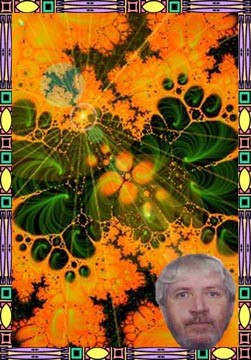 |
Fig. 14. John W. Allen
Photo by Dave of Beauty and the Books, 1997 |
John W. Allen #
is an amateur ethnomycologist living in North America. Mr. Allen is the author of ten books (including Magic Mushrooms of the Pacific Northwest (1976-1997) the oldest selling identification guide on entheogenic mushroom identification) and more than two dozen articles on the subject of visionary mushrooms and the editor and author of the series Ethnomycological Journals Sacred Mushroom Studies. Additionally, Mr. Allen has photographed mushrooms in America, Hawai'i, Southeast Asia, Great Britain and Europe.Furthermore, Mr. Allen is the discoverer of a new entheogenic mushroom species from Thailand, named Psilocybe samuiensis Guzmán, Bandala and Allen. Since the late 1980's Allen has lectured at conferences and symposia, given many slide-show presentations on the history and identification of entheogenic mushrooms and mushroom art throughout the ages at various universities world-wide. His current works include the new CD-ROM, Volume V of Ethnomycological Journals Sacred Mushroom Studies, Psilocybian Mushroom Cultivation: A Brief History co-authored with Jochen Gartz, Volume VII: Mushroom Pioneers (February 2002) and a forthcoming bibliography of psilocybian and other species of Entheogenic Fungi also co-authored by Dr. Jochen Gartz of the University of Leipzig, Germany.
Richard Alpert #
, also known as Baba Ram Dass, was Timothy Leary's colleague. He has worked extensively in the field of transcendental meditation, yoga and other eastern philosophies. Alpert, along with Leary, obtained a supply of synthetic psilocybine from Sandoz for use in experiments on prisoners at the Concord State Prison in Massachusetts.James Arthur # (1958-2005)
was deeply involved in studying mushrooms and religion. He was an author, lecturer, and performer who argued that A. muscaria and psilocybian mushrooms were very influential in Christianity and other religions. Arthur explored the idea that Religions have become entities far removed from their original intention as helpers of mankind and have, through ego-inspired mis-interpretation of revelation and/or simple control motivation, becomes oppressive to mankind. His views were controversial and disputed by other authors in the field. Arthur also spoke publicly about other topics such as UFOs.Wolfgang Bauer #
is a a German psychologist who has studied extensively on optical illusions by Prof. Rausch at the J.W. Goethe-Universität in Frankfurt/Main. Bauer is also editor of Sergius Golowin's classic treatise on witches herbs and magic mushrooms (Magie der verbotenen Märchen, Hamburg, 1973), which became a cult-book in the Seventies and which was secretly xerox-copied in the then communistic eastern part of Germany and later redistributed in the hippie-underground there. Furthermore, Bauer is co-editor of Integration - Journal for Mind-Moving Plants and Culture and also editor and co-author of Der Fliegenpilz - Traumkult, Märchenzauber, Mythenrausch (Aarau 2000). His collection of objects relating to the fly-agaric has been exhibited by the Karl Ernst Osthaus-Museum (Hagen) several times throughout many European Museums.Michael Beug #
was Academic Dean at Evergreen State College in Olympia, Washington. Beug has taught mushroom identification at Evergreen and at mushroom conferences throughout the U.S.A. since 1972. He is also a contributor of photographs to more than a dozen books, and has published numerous scientific papers on mushroom toxins and mushroom- identification keys.Frank Barron #
was a colleague of Timothy Leary, who first told Leary that he had brought some mushrooms he had obtained in México back to Harvard. This was the first Leary had heard of their special power, and later inspired Leary to ingest these special mushrooms.Antonio Bianchi #
is an Italian anesthesiologist and toxicologist, and is an expert on visionary mescaline-containing cacti from Perú (San Pedro) and México (péyote). Bianchi has also studied the soma mushroom, Amanita muscaria.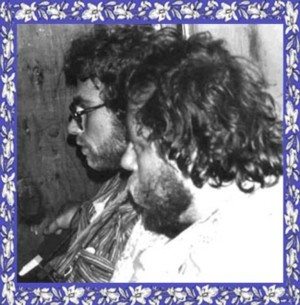 |
Fig. 15. Jeremy Bigwood (right)
Photo: Linda Dear |
Jeremy Bigwood #
is a biochemist and mushroom cultivator. In the late 1970's Bigwood was a co-ordinator of the Second International Conference on Hallucinogenic Mushrooms, where he lectured on new and improved methods for the cultivation of Psilocybe cubensis. Bigwood was also co-editor with Jonathan Ott and contributor to Teonanacatl: Hallucinogenic Mushrooms of North America. He attended Evergreen State College in Washington State where he collaborated both with Michael Beug and Jonathan Ott. Bigwood and Michael Beug contributed two scientific articles to the Journal of Ethnopharmacology on potency levels of in vitro grown specimens of P. cubensis and other psilocybian mushrooms from the Pacific Northwest of the United States. Furthermore, Bigwood and Ott presented one of the first methods for inoculating shrooms spores using syringes.Richard Glen Boire #
is a California attorney who defends clients charged with drug-law violations. He is the publisher of a newsletter The Entheogenic Law Reporter, devoted to drug-related law and news. Boire is also the author of Sacred Mushrooms and the Law and Marijuana Law.Masha Wasson Briten #
is the adopted daughter of R. Gordon Wasson, who, along with her mother, Valentina Pavlova Wasson, became the first westerner to consume the magic mushrooms outside of a ceremonial context.J. Christopher Brown #
is a graduate student in Botany at the University of Massachusetts who helped to organize the Gordon and Tina Wasson Ethnomycological Collection at the Harvard Botanical Museum.Carlos Castaneda #
is an anthropologist who has written several novels ostensibly about a Yaqui Indian medicine-man named Don Juan. In the what is the first saga, being an account of an alleged relationship with a Yaqui Indian medicine man, The Teachings of Don Juan: A Yaqui Way of Knowledge, mentions a smoking-mixture which Don Juan allegedly referred to as humilito.According to Castaneda, this smoking-mixture contained psilocybian mushrooms ground into a fine powder. This book led many pilgrims to México in search of the "magic mushrooms." It should be noted that no other Yaqui Indians are known to use psilocybian mushrooms, nor have the mushrooms ever been reported to be smoked elsewhere by anyone in México.
Stephan F. de Borhegyi #
is an archeologist who studied the mushroom stones of Middle America and published a few papers regarding them.Jim de Korne #
is the author of Psychedelic Shamanism and has contributed two chapters in his book on the sacred mushrooms.Richard de Mille #
has exhaustedly studied the Carlos Castaneda controversy in the process shedding doubt on the authenticity of Castaneda's research and his books concerning his relationship with the (to De Mille) non-existent shaman, Don Juan.Herman de Vries #
is a Dutch artist who is also editor-in-chief of Integration - Journal of Mind Moving Plants and Culture. De Vries, spent most of his life suffering from asthma. Doctors told him that he would not lived beyond fifty years of age. However, on the 17th of January 1970, De Vries said goodbye to his illness after an LSD-experience which forever changed his life. And since that very day he has been in the best of health. De Vries believes that as a humans we all have an existential basic right to test and experience all the possibilities which nature offers us. As an artist, De Vries has participated in almost 500 exhibitions and his works are represented in 48 museums.Rick Doblin #
is the founder and current president of MAPS (Multidisciplinary Association for Psychedelic Studies) and has recently conducted a follow-up study to Timothy Leary's, Concord Psilocybin Prison Project. Rick is currently in the Ph.D. program in Public Policy at Harvard's Kennedy School of Government and has previously graduated from Stan and Christina Grof's Holotropic Breathwork 3-year training program.Wendy Doniger O'Flaherty #
was co-author with R. Gordon Wasson of Soma: Divine Mushroom of Immortality, and is an expert on the Hindu epic Reg Veda, also having edited an anthology with some of the original text.William Emboden #
is Professor of Biology at the University of California at Northridge and author of Narcotic Plants, an excellent book on visionary and other psychoactive plants. A section of this fine book is devoted to mushrooms.Leonard Enos #
is author of the first identification manual for psilocybine-containing mushrooms common in the Pacific Northwest United States. Mr. Enos' Alvaro Estrada #
is a Mazatec Indian who speaks and writes Spanish. His interviews with María Sabina were the basis for her autobiography Vida de María Sabina: La Sabia de Hongos, translated into French as "Autobiographie de María Sabina: La Sage aux Champignons Sacrés"; English as "María Sabina: Her Life, Her Chants"; into Portuguese as "A Vida de María Sabina, a Sabia dos Cogumelos"; and in German as "María Sabina: Botin der Heiligen Pilze".Michael Fehr #
is director of the Karl Ernst Osthaus-Museum in Hagen (Germany). Fehr has organized several exhibitions on the studies and use of the fly-agaric mushroom Amanita muscaria. One article of importance to this work has Dr. Fehr discussing the role of psychoactive fungi as objects of museum didactic considerations published in Der Fliegenpilz - ein kulturhistorisches Museum (Köln, 1991), a book, of which Michael Fehr is also the editor.Francisco Festi #
is a researcher of entheogenic mushrooms and author of Funghi Allucinogeni: Aspetti Psicofisiologici E Storici (in Italian, 1985). An excellent book covering both Old and New World histories of usage, chemistry and pharmacology of these interesting mushrooms.Nat Finkelstein #
was just a young student when he traveled to México in the late 1960's. While their he was most fortunate to consume the sacred mushrooms. Finkelstein later wrote of his experience in an article for Psychedelic Review "Hongi Meester" relating his personal mushroom velada with María Sabina.Peter Furst #
is Professor Emeritus of Anthropology at the State University of New York at Albany, a member of the American Department of the University Museum at the University of Pennsylvania, and a research associate in ethnobotany at the Botanical Museum of Harvard University. Furst is the author of Hallucinogens and Culture; Flesh of the Gods; and Mushrooms: Psychedelic Fungi. The latter is part of the Encyclopedia of Psychoactive Drugs series.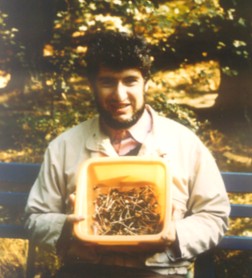 |
Fig. 16. Jochen Gartz
|
Jochen Gartz #
is a biochemist and mycologist at the University of Leipzig, Germany. Gartz is also founder of the Department of Fungal Biotransformation at that University. Gartz has traveled extensively and conducted field-research in Europe, South Africa and the US Pacific Northwest. He has authored more than 50 scientific papers on the chemistry and cultivation of entheogenic mushrooms and has authored field guides (publ. in German and English) for the identification of psilocybian mushrooms. Gartz is the discoverer of a new entheogenic mushroom from Africa, which he named Psilocybe natalensis. His books include Magic Mushrooms Around the World (1996), an English translation of of the two German editions of "Narrenschwämme" (1993); and (co-authored two books on CD-ROM with John W. Allen) "Magic Mushrooms in Some Third World Countries" (1998) and "Psilocybian Mushroom Cultivation: A Brief History" of which the latter is currently being translated into a German edition by Gartz.Rich Gee #
is co-author with Jule Stevens of How to Grow and Identify Psilocybin Mushrooms and author of an aquarium guide to the latest techniques for growing psychoactive mushrooms, Cubensis Aquarium Gardening Workbook Edition. Mr. Gee is a pioneer in the field of mushroom cultivation.Ewold Gerhardt #
is a European mycologist who has just published a revision of the genus Panaeolus.Hartmut Geerken #
is a german writer, musician and paramycologist. As a child Geerken shared a symbiotic relationship with wild edible mushrooms which helped in his survival during the famine after world war II. Increasingly intererested in fungi Geerken eventually became the Editor-in-Chief of Paramykologische Rundschau (a paramycological review; 1979 cont.). Geerken also conducted several field studies of Afghan fungi and in the late 1970s along the Afghan-Pakistani border discoverd the up to then unknown "boletus (tubiporus) pactiae gee". (s. Afghanistan Journal, Graz; 1978/1). Geerken also worked on hallucinogenic mushrooms and mycological folklore healing practises in the middle hindukush and introduced the term rabenbrot to the mycological discussion. In Namibia he did research on the Termitomyces 'omajowa'. Additionally, Geerken has also published numerous books of contemporary literature, directed radio plays and performances and composed musical works in which mushrooms always played an important role. He is also playing the musical works of the mycologist John Cage.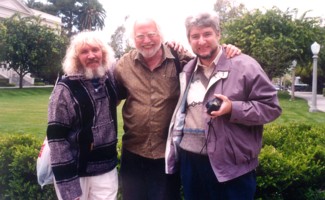 |
Fig. 17. John W. Allen, Sasha Shulgin and Jochen Gartz
Chapman University, 1994 |
Allen Ginsburg #
was one of the first people Timothy Leary introduced to psilocybian mushrooms. According to Leary, Ginsburg, after becoming inebriated by the mushrooms, ripped-off all of his clothes and from Leary's Millbrook estate ran stark naked down the street and was not to be heard from until several months later.F. F. Ghouled #
is author of The Field Guide to Psilocybin Mushrooms. Ghouled, along with colleague Richard Meridith, later published Psilocybin Cultivation after changing his name to F. C. Gould. This former book described collection of Psilocybe cubensis found only in the Southeastern United States from Texas to Florida and north to Georgia. Ghouled also alleged Amanita muscaria was the famed "magic mushroom" of México [sic!] and mis-identified two photographs of Psilocybe cubensis in their young stage of grow as Panaeolus subbalteatus.Sergius Golowin #
is a renown Swiss writer and folklorist, who in his book Die Magie der verbotenen Märchen (Hamburg, 1973), was the first person to infer that there was a connection between the caps of the dwarfs and other beings in fairy tales and the appearance of the fly agaric, a mushroom which sports a red cap (hat). Golowin is also the founder of the Psychedelic Folklore (Psychedelische Volkskunde) and has made in the early Seventies, a very impressive experiment when he bioassayed seven dried caps of the fly agaric. The account of his experience is printed in Der Fliegenpilz - Traumkult, Märchenzauber, Mythenrausch. Furthermore, when Dr. Timothy Leary was arrested in Switzerland after his flight from the U.S.A., Golowin started an initiative intended to get Leary out of Swiss prison and later attempted to help Leary get a residence permit for Leary to remain in Switzerland.Adam Gottlieb #
is author of The Psilocybin Producer's Guide, a poorly written book on cultivation with several identification errors which were never corrected in subsequent printings (Psychedelic Underground Library: Nine Rare Classics) and reissues of the original book and later the same errors were reprinted in an updated version of his booklet retitled as Psilocybin Production.Robert Graves #
was a British author and historian Who wrote also on Greek Mythology and was one of the first persons to whom R. Gordon Wasson gave the sacred-Mexican mushrooms. Graves wrote several articles about mushrooms, including one in which he described his experience while under the influence of psilocybian mushrooms--This article appeared in an issue of Holiday magazine (Graves, 1962).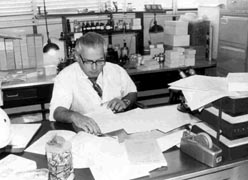 |
Fig. 18. Gastón Guzmán in his laboratory
working on his Monograph The Genus Psilocybe |
Gastón Guzmán #
is a Mexican mycologist, co-founder and past President of the Mexican Mycological Society. Guzmán has spent more than 44 years studying mushrooms, working mainly in taxonomy, ecology and ethnomycology. He presently works at the Instituto de Ecología, Xalapa, Veracruz, México, where he founded the Mycology Department in 1989.Guzmán has published more than 350 papers on fungi and 8 books. His first book, published in 1977 was the first mushroom field guide published in Mexico. In 1983 Cramer published his monograph on Psilocybe (now out of print): The Genus Psilocybe: A Systematic Revision of the Known Species Including the History, Distribution and Chemistry of the Hallucinogenic Species . In 1995 Cramer also published a supplement to that monograph. Guzmán had described more than one hundred new species of Psilocybe throughout the world. His most recent book, published in 1997, is a checklist of Spanish names for mushroom species of Latin American mushrooms, a monumental work covering more than 5,500 common names with scientific equivalents ( over 1600 species). Guzmán began his first studies in 1955 and 1957 became field assistant to Rolf Singer, then investigating the hallucinogenic fungi of México. In an obscure village of southern México, Guzmán attended an Indian ceremony where he partook of the visionary mushroom (Psilocybe cubensis).
Since 1995 and 1997 Guzmán has been honored as an Emeritus National Research Fellow in Mexico and an Emeritus Research Fellow of his Institution. Guzmán's current work is A Worldwide Geographical Distribution of the Neurotropic Fungi, Analysis and Discussion, a listing all of the known psychoactive species (218 and counting) and their worldwide distribution, co authored with John W. Allen and Jochen Gartz. This large monograph will appear in the Italian Journal Annal des Musei Civici de Rovereto. Guzmán is considered to be the leading authority on the taxonomy of the Mexican entheogenic mushrooms.
Richard and Karen Haard #
were not directly involved in the study of hallucinogenic mushrooms, but they did publish in the mid-1970's one of the first field guides devoted specifically to the identification of both poisonous and hallucinogenic mushrooms of the Pacific Northwest United States. Richard Haard, Ph.D., is a graduate of Kansas State University, and formerly an associate Professor of Biology at Western Washington State College. Haard taught at the Nature Study Institute, Bellingham, Washington, which he and his wife Karen founded in 1974, and also worked as a biological-system consultant for various Indian tribes of North America. Karen Haard, B.Sc. is also a graduate of Kansas State University, and a former research technician in a biological laboratory.Joan Halifax #
is an anthropologist with an interest in shamanism and preliterate cultures that have used drug-plants. She was a close friend of R. Gordon Wasson's.Martin Hanslmeier #
is a German physician and psychotherapist who has been engaged in the study of mycology since childhood. Hanslmeier is also a painter and photographer of psychoactive fungi. His study on German psychoactive mushrooms (Mykographie einer Wiese in der Rhön) has been printed in Herman de Vries' catalogue of a large collection of herbs and plants (natural relations, Nürnberg 1989). Also numerous articles on magic mushrooms have appeared in many journals and publications throughout Germany.Bob Harris #
is the author of Growing Wild Mushrooms and the creator, along with David Tatelman, of the Homestead Mushroom Kit. Harris also invented a wheat-straw pasteurizer to be used in mushroom cultivation.Roger Heim #
was the noted French mycologist who accompanied R. Gordon Wasson on several expeditions into the Sierra Madre of México and identified taxonomically the first seven species of hallucinogenic fungi used in traditional healing ceremonies in Oaxaca, México [see Wasson, 1957; Heim & Wasson, 1958]. Heim contributed amply to scientific journals, including more than fifty articles concerning the sacred mushrooms of México and, together with his colleague Roger Cailleux and many other specialists, was first to cultivate the entheogenic mushrooms.Margaret Holden #
is an English mycologist who reported on the poisoning of a young boy who had allegedly consumed Panaeolina foenisecii. Similar intoxications were reported by the Australian physician R. V. Southcott (1974) and by the American mycologist Orson Miller, (1971).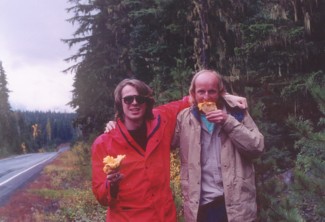 |
Fig. 19. Jim Jacobs and Karl L. R. Jansen
Chantrelle hunting, Breittenbush, Oregon, 1991 |
Hans van den Hurk #
is the founder of the Conscious Dreams Smart Shop and wholesale operation in Amsterdam, which legally sells fresh psilocybian mushrooms, péyotl and other natural entheogens. Conscious Dreams, which now has five shops in Holland, was the first Smart Shop in Amsterdam and also the first to offer psilocybian mushrooms for sale. Conscious Dreams is renowned throughout Europe. Currently The legality of psilocybian mushrooms in the Netherlands is being challenged by the courts.Aldous Huxley #
spent the last decade of his life in the study of entheogens, after Humphrey Osmond introduced him to mescaline in 1953. Mr. Huxley is the author of Brave New World and Island, both of which were about drugs and their integration into society.Jim Jacobs #
has done field-work on psychoactive mushrooms throughout México, Canada, and the United States since 1975. His collections were described in the monograph The Genus Psilocybe by Gastón Guzmán. Jacobs is a member of the Oregon Mycological Society's Toxicology Committee and is an independent consultant with Oregon's Poison Control Center. Recently a species of Psilocybe was named in his honor (Psilocybe jacobii Guzmán.Karl L. R. Jansen #
is the co-author, M. D., Ph. D., is a member of the Royal College of Psychiatrists and is the co-author, together with John W. Allen and Mark D. Merlin, of the paper An Ethnomycological review of Psychoactive Agarics in Australia and New Zealand, was published in a 1991 issue of Journal of Psychoactive Drugs. Jansen is also one of the worlds leading experts on ketamine. He has studied ketamine at every level: from photographing the receptors to which ketamine binds in the human brain, to publishing numerous papers on his discovery of the similarities between ketamine's psychoactive effect and the near-death experience. His writings have appeared in over 30 medical journals and popular magazines of our times.
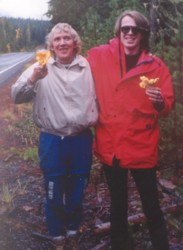 |
Fig. 20. John W. Allen
and Karl L. R. Jansen Breittenbush, Oregon, 1991 |
Irmgard Weitlaner Johnson #
is a specialist in prehispanic and contemporary Mesoamerican textiles and was one of the first westerners to witness a sacred mushroom ceremony.Everett Kardel #
, A pioneer in publishing a successful Indentification manual for Pacific Northwet Psilocybe mushrooms is an Oregon author of an early identification guide for mushrooms of the Pacific Northwest (Magic Mushrooms), a unique pamphlet printed on a mimeograph machine.Keewaydinoquay #
[M. Peschel] is a North American Indian shaman from Miniss Kitigan, Michigan, a member of the Ahnishinaubeg, one of the few Native American tribes (located in Northern Michigan and Southern Ontario known to uses a mushroom [Amanita muscaria] in a ceremonial context.Edzard Klapp #
has studied under the tuttledge of the well-known German mycologist Hans Haas (Die Pilze Mittel-Europas), having, at an early age, discovered the strangeness and the hidden secrets of the sacred fungi. In 1971, Klapp encountered The Sacred Mushroom and was began a long-time correspondence with the author John Marco Allegro. Further nurturing Allegro's beliefs, Klapp wrote an essay in 1982 (Rabenbrot). In this essay, Klapp discusses the amanita and its relationship and its association in hypothesis to the bread which the raven brought to Elija the prophet in the Holy Bible. This essay has been reprinted on many ocassions. The metalinguistic term "intentional speech" proved hereby of heurestic value. Carrying on his thesis, Klapp wrote The Masks of the Fly Agaric printed in Der Fliegenpilz - Traumkult, Märchenzauber, Mythenrausch (Aarau 2000).Stanley Krippner #
, Ph.D., is Professor of Psychology at Saybrook Graduate School, San Francisco, California. He is a Fellow of the American Psychological Association, the Association of Clinical and Experimental Hypnosis, the Society for the Scientific Study of Sex, and is a Charter Fellow of the American Psychological Society and the American Academy of Clinical Sexologists. He is a member of the American Anthropological Association, the Association for the Study of Dreams, The International Council of Psychologists, the InterAmerican Psychological Association, The American Academy of Social and Political Science, the Center for Shamanic Studies, and a Charter Member of the International Society for Multiple Personality and Dissociation. He served as Director of the Dream Laboratory at Maimonides Medical Center in Brooklyn for ten years, and for three years was director of the Child Study Center, Kent State University. Dr. Krippner has been a visiting Professor at the College of Life Sciences, Bogota, Colombia and the University of Puerto Rico, and a Lecturer at the University of Minais Gerais, Belo Horizonte, Brazil. He is co-author of several books, including The Mythic Path, Personal Mythology, Spiritual Dimensions of Healing, and Healing States, co-editor of Broken Images, Broken Selves, and editor of Dreamtime and Dreamwork as well as eight volumes of Advances in Parapsychological Research. He has authored or co-authored over 500 journal articles, book chapters and monographs. Dr. Krippner, along with co-author Michael Winkleman, contributed a fine article on María Sabina to The Journal of Psychoactive Drugs and has a long term interest in shamanic medicine of Third World countries.Weston LaBarre #
is an anthropologist with a special interest in the use of entheogens by primitive societies. He is author both of The Peyote Cult, the definitive book on the peyote religion, and The Ghost Dance: The Origins of Religion and numerous journal publications on the subject of drug-use in primitive cultures.Martin A. Lee and Bruce Shlain #
are authors of Acid Dreams: The CIA, LSD, and the Sixties Rebellion, a book which retells the story of the CIA infiltration of R. Gordon Wasson's expedition to México in 1956. Their book also provides some insight into Timothy Leary's research at Harvard. See John Marks and Jay Stevens.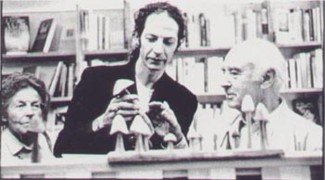 |
Fig. 21. Anita Hofmann, Roger Liggenstorfer
and Albert Hofmann. Photo: Hansjörg Sahli |
Roger Liggenstorfer #
is co-editor of María Sabina. Botin der heilige Pilze. Liggenstorfer has contributed numerous articles to scientific publications. Additionally, Liggenstorfer also believes in "Oink" (the hidden power of Psilocybe cyanescens) which is derived from an experience on Psilocybe cyanescens, see his book on María Sabina.Gary Lincoff #
is president of the North American Mycological Society, employed at the New York Botanical Garden and is editor of the Audubon Field Guide to the North American Mushrooms and The Simon and Schuster Mushroom Field Guide. Lincoff has also contributed, with D. H. Mitchell, a 35-page chapter to the book Toxic and Hallucinogenic Mushroom Poisoning.Frank J. Lipp #
is professor in the Department of Anthropology of Duke University and has studied the use of psilocybian mushrooms among the Chinantec and Mixe of Oaxaca, México.Bernard Lowy #
was professor Emeritus in the Botany Department of Louisiana State University. He has served for 15 years as a member of the editorial board of Mycologia and contributed numerous articles on hallucinogenic mushrooms, including describing his collection of Psilocybe mexicana in Guatemala. He is posthumous co-author of a forthcoming book on the history of entheogenic mushrooms.Thomas Lyttle #
is editor and publisher of the now-defunct journal Psychedelic Monographs and Essays. Currently the editor of Psychedelics reimagined.John Marks #
is author of The Search for the Manchurian Candidate. Marks first uncovered the story of the CIA's infiltration of R. Gordon Wasson's Mexican mushroom expedition in 1956. See related information under James Moore, Jay Stevens and Lee & Shlain.Dennis McKenna #
has been involved in the interdisciplinary study of ethnopharmacology and plant hallucinogens for the past 25 years. He is co-author, with his brother Terence, of The Invisible Landscape: Mind, Hallucinogens, and the I Ching, a philosophical and metaphysical exploration of the ontological implications of psychedelic drugs which resulted from the two brothers' early investigations of Amazonian hallucinogens in 1971. He received his doctorate in 1984 from the University of British Columbia. His doctoral research focused on ethnopharmacological investigations of the botany, chemistry, and pharmacology of ayahuasca and oo-koo-he, two orally-active tryptamine-based hallucinogens used by indigenous peoples in the Northwest Amazon. Following the completion of his doctorate, Dr. McKenna received post-doctoral research fellowships in the Laboratory of Clinical Pharmacology, National Institute of Mental Health, and in the Department of Neurology, Stanford University School of Medicine. In 1990, he joined Shaman Pharmaceuticals as Director of Ethnopharmacology. He relocated to Minnesota in 1993 to join the Aveda Corporation, a manufacturer of natural cosmetic products, as Senior Research Pharmacognosist. He currently works as a scientific consultant to clients in the herbal, nutritional, and pharmaceutical industries. Together with two colleagues in the natural products industry, he incorporated the non-profit Institute for Natural Products Research (INPR) in October 1998 to promote research and scientific education with respect to botanical medicines and other natural medicines. Additionally, Mckenna serves on the Advisory Board of the American Botanical Council, and on the Editorial Board of Phytomedicine, International Journal of Phytotherapy and Phytopharmacology.He is a founding board member and Vice-President of the Heffter Research Institute, a non-profit scientific organization dedicated to the investigation of therapeutic applications for psychedelic plants and compounds and has also served as board member and Research Advisor to Botanical Dimensions, a non-profit organization dedicated to the investigation of ethnomedically significant plants. He was a primary organizer and key scientific collaborator for the Hoasca Project, an international biomedical study of Hoasca, a psychoactive drink used in ritual contexts by indigenous peoples and syncretic religious groups in Brasil. He has conducted extensive ethnobotanical fieldwork in the Peruvian, Colombian, and Brasilian Amazon. He has served as invited speaker at numerous scientific congresses, seminars, and symposia. Dr. McKenna is author or co-author of over 35 scientific papers in peer-reviewed journals. His publications have appeared in the Journal of Ethnopharmacology, European Journal of Pharmacology, Brain Research, Journal of Neuroscience, Journal of Neurochemistry, Journal of Nervous and Mental Disease, Economic Botany, and elsewhere. Additionally, Dennis Mckenna and his brother Terence, using the pseudonyms O. N. Oeric and O. T. Oss, published the first popular of several psilocybin mushroom growing guides in the 1970s. In fact, it was Dennis Mckenna who actually devised the technology for growing these mushrooms in jars.
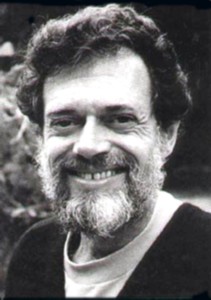 |
Fig. 22. Terence McKenna
|
Terence McKenna #
was a world-renowned guru of sacred mushrooms, author, evangelistic proselyte of the Amazon and the mind; and a noted lecturer, specializing in shamanic-plants, entheogens from the Amazon and spiritual transformation. Born in 1946, Mckenna has spent the last twenty-five years of his life studying the ontological foundations of shamanism, in digesting mushrooms, yopo snuff, and ayahuasca. Together with his brother Dennis he published The Invisible Landscape: Mind, Hallucinogens and the I Ching, a scientific and philosophical effort to explain the results of their investigations into the phenomena of time and tryptamine pharmacology.A narrative of the brothers adventures in the Amazon was the subject of a later book by Terence, True Hallucinations, although his last trip to the Amazon occurred in 1981 when he accompanied his brother Dennis on an expedition, sponsored by the University of British Columbia, to investigate the use of oo-koo-he, an orally active Virola hallucinogen used by the Witotos and Boras in Peru and Columbia. A graduate of the University of California at Berkeley, McKenna survived the sixties by traveling extensively in the Asian and New World Tropics and extensively studied and lectured on shamanism of the Amazon basin. Terence, along with his wife Kat Harrison and brother Dennis, was also a co-founder of Botanical Dimensions, a non-profit botanical garden on the Island of Hawai'i. Additionally, Terence was a popular lecturer among college students. Besides being co-author with his brother Dennis The Invisible Landscape and the classic cultivation guide written under the pseudonyms of Oeric and Oss, Terence wa also the author of Food of the Gods. Terence passed away in April, 2000 from terminal brain cancer and he will be surely be missed by those whose paths he crossed and touched.
Gary Menser #
was a real estate agent in Florence, Oregon and a past President of the Eugene, Oregon Mycological Society. He was author of Hallucinogenic and Poisonous Mushroom Field Guide (later retitled Magikal Mushroom Handbook). Menser was also an expert on truffles and their collection.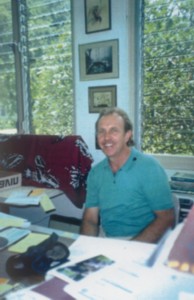 |
Fig. 23. Mark D. Merlin
In his office, Hawaii |
Mark D. Merlin #
is a biogeographer in the Biology Program of the University of Hawai'i at Manoa with special interest in the ethnobotany and cultural history of entheogenic plants. He has published academic press books on Cannabis [Man and Marijuana: Some Aspects of Their Ancient Relationship, Fairleigh Dickinson, University Press, 1972], opium or [Papaver somniferum [On the Trail of the Ancient Opium Poppy, Associated University Presses, 1984], and more recently co-authored a book kava (Piper methysticum), an important traditional drug-plant of many Pacific Islands [Kava: The Pacific Drug, Yale University Press, 1992] The latter publication was later retitled as Kava: The Pacific Elixer. Dr. Merlin has also co-authored seven papers with John W. Allen on identification and non-traditional use of entheogenic mushrooms in Hawai'i and Southeast Asia.Richard Alan Miller #
is a warlock and herbalist who co-authored with David Tatleman the first psilocybian mushroom handbook featuring color photographs for identification of psilocybian mushrooms: The Magikal Mushroom Handbook. Miller also wrote another book, Magikal and Ritual Use of Herbs. In the first edition of the latter publication, Miller reported on the (non-existent) sexual mushroom-rituals of the Mazatec Indians. However, the Indians of Oaxaca refrain from any sexual activity for three days before and after a sacred mushroom ceremony. This portion of Mr. Miller's book was removed from subsequent editions.James Moore #
was a CIA "short order cook" [a chemist] who infiltrated one of R. Gordon Wasson's mushroom expeditions to Oaxaca, México in 1956. Moore even ingested the mushrooms during a ceremony and according to Peter Stafford (1992), in Moore's own words, Moore recalls that "I had a terrible cold, we damned near starved to death, and I itched all over. There was all this chanting in the dialect. Then they passed the mushrooms around, and we chewed them up. I did feel the hallucinogenic effect, although `disoriented' would be a better word to describe my reaction." Obviously Moore had an uncomfortable experience, probably due to the fact that he was not whom he appeared to be. His mind caught up with his phoniness and placed him in an awkward and uncomfortable position. Mr. Moore eventually returned to his laboratory in Delaware where he attempted in vain to isolate the active compounds from the mushrooms.--compounds which were to be used by the CIA in "non-conventional chemical warfare." Luckily for all of us, Moore was unsuccessful in this endeavor.Henry Munn #
contributed an excellent essay on the mushrooms of language (Munn, 1973).Richard Hans Norland #
is author of What's In A Mushroom? Part Three, a book on psilocybian mushrooms which contains a lot of graphs and charts on the chemical analysis of certain species of entheogenic fungi which were collected in the Pacific Northwest region of the United States. It should be noted that Norland failed to publish What's in a Mushroom? Parts One and Two. Furthermore Norland also advertised a psilocybian bibliography for $5.00 in advance of publication--This volume was never published.György-Miklos Ola'h #
is a mycologist and chemist at Laval Université in Québec, Canada. In the late 1960,'s Ola'h conducted several studies of the genus Panaeolus and published a monograph, Le Genre Panaeolus, identifying several species Panaeolus mushrooms as latent psilocybian and/or non-psilocybian. Ola'h also studied species from Southeast Asia, Africa and the Philippines.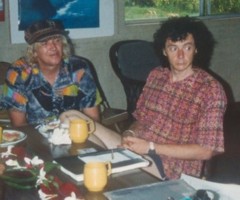 |
Fig. 24. John W. Allen and Jonathan Ott
Botanical Preservation Corps, Maui, 1994 |
Jonathan Ott #
is an ethnopharmacolgnosist, natural-products chemist and botanical researcher, is considered by many to be the "Master of Entheogens." A protégé of R. Gordon Wasson, Ott was one of the original organizers of the now-famous mushroom conferences of the late 1970's. Ott is founder of Natural Products Co., a small chemical- manufacturing business based in Vashon, Washington.He is a fellow of the Linnean Society, and a long time member of the American Association for the Advancement of Science, the Society for Economic Botany and the Society of Ethnobiology. Ott co-authored a book and paper with his friend and teacher, the late ethnomycologist R. Gordon Wasson and has also collaborated closely with Richard Evans Schultes and Albert Hofmann. Furthermore, Ott is the author of Hallucinogenic Plants of North America, book on The Proceedings of the 2nd International Conference on Hallucinogenic Mushrooms, Teonanácatl: Hallucinogenic Mushrooms of North America (co-edited with Jeremy Bigwood) both out-of print, as well as The Cacahuatl Eater: Ruminations of an Unabashed Chocolate Addict, Pharmacotheon: Entheogenic Drugs, their Plant Sources and History. Most recently he published a book on the famous South American visionary-drug, Ayahuasca Analogues, as well as The Age of Entheogens and The Angels' Dictionary and Pharmacophiles ir the Natural Paradises. Ott is working on a book of shamanic snuffs. Ott, together with Rob Montgomery, conducts annual seminars under the auspices of Entheobotany Seminars Corps. These annual entheogenic-plant seminars have taken place in Equador, Maui, Hawai'i, Veracruz and Palenque, Mexico.
Steven Peele #
is curator and President of the Florida Mycology Research Center. At one time, Mr. Peele was the only private citizen in the United States who had a Schedule One permit for possession and sale of psilocybe spores, mushrooms and mushroom-cultures. Due to unorthodox methods for storage of such material, the DEA withdrew his permit. Peele publishes a newsletter, The Mushroom Culture: Journal of Mushroom Cultivation and a second Journal, TEO: The International Journal of Psychoactive Mushrooms..Eunice V. Pike and Florence Cowan #
are Wycliff Bible translators who lived among the Mazatec Indians of Oaxaca. They wrote two articles in Practical Anthropology on the Mazatecs who used magic mushrooms albeit Christian converts. These two women and Richard Evans Schultes gave R. Gordon Wasson the incentive to search for the mushroom cult he rediscovered in México.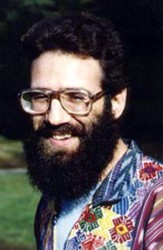 |
Fig. 25. Steven Hayden Pollock
1st International Conference on Hallucinogenic Mushrooms, 1976 Photo: Linda Dear |
Steven Hayden Pollock #
followed in Andrew Weil's footsteps by reporting in scientific journals, a history of the contemporary use of psilocybin mushrooms as recreational drugs. Pollock also contributed several noteworthy papers on both Psilocybe and Panaeolus species to the scientific and academic communities. He was the first investigator to report on the use of visionary mushrooms in Hawai'i. Pollock was also involved in the propagation of Psilocybe cubensis and is noted for the marketing of what he referred to as "Cosmic Camote" or "Philosophers Stone." These epithets were given to the sclerotia of a new species discovered by Pollock, Psilocybe tampanensis. Pollock also produced a potent strain of Psilocybe cubensis which he named Matias Romero after a town in southwestern Mexico and was the first cultivator to use horse manure and straw compost for cultivating the visionary mushrooms.Andrija Puharich #
was a man who overcame poverty and many personal tragedies who etched his way through medical school, going on and establishing a Parapsychological research foundation to oversee his medical discoveries which covered over 75 patents. Puharich was a maverick, a dedicated researcher, a rebel scientist, scorned by colleagues, and revered and encouraged by those gifted with foresightedness, including Aldous Huxley. His involvement in the field of ethnomycology began when he first filmed forays delving into the ancient mysteries and secrets of the sacred mushroom rites of the Chatino Indians of Mexico and later, on a trip to to the Hawaiian Islands where Puharich, along with Hawaiian Kahuna David Bray sought evidence that a mushroom may have been used and played an important role in the early religious rites of the Hawaiian people. Unfortunately, Puharich reported that he had not uncovered any conclusive proof supporting the mushroom theory, based on documented evidence which claimed that the mushrooms, which when eaten, gave the user extra-sensory perception. It was because of the similarity between the Hawaiian word "akua" referring to the supernatural and the word "aku" with a similar meaning in five other areas of the world which brought Puharich to Hawaii. Puharich was also interested in and supported Uri Geller, UFO's and was an authority on E.L.F. (extremely low frequency magnetic fields), pollution and its effects on human organisms. His book The Sacred Mushroom: Key to the Door of Eternity is a classic testament to his beliefs in the historical value of these mushrooms. |
Fig. 26. C. Rätsch
and R. Liggenstorfer |
Christian Rätsch #
is a cultural anthropologist from Hamburg, Germany, specializing in the sacred and secular use of magical plants. His fieldwork among the Lacondos of Chiapas includes study of Datura and balché potions. Rätsch's books include Gateway to Inner Space, Dictionary of Sacred and Magical Plants, and diverse publications on the Maya, alchemy, psychedelics, aphrodisiacs and oracles. Rätsch and his colleague Roger Liggenstorfer co-authored and edited a translation of Estrada's book on the life and times of the Mexican shaman Doña María Sabina (Maria Sabina: Botin der Heiligen Pilze). Rätsch is also editor of The Yearbook for Ethnomedicine and the Study of Consciousness and author of Enzyklopädie der psychoaktiven Pflanzen. Botanik, Ethnopharmakologie und Anwendungen.Alan B. Richardson #
is a professional photographer and was a personal friend of R. Gordon Wasson. Richardson's photographs of María Sabina and her nocturnal velada graced the pages of Life magazine [May 13, 1957]. Richardson was the first outsider together with R. Gordon Wasson, to eat the sacred mushrooms.Thomas J. Riedlinger #
is a researcher who was editor of The Sacred Mushroom Seeker: Essays for R. Gordon Wasson. This book contains numerous essays in honor of R. Gordon Wasson, written by those who knew him best.Ronald Rippchen #
is the author and editor of a German book devoted to psilocybian mushrooms. Numerous articles by well- known authors in this field are presented and the book is lavishly illustrated.Alexandra Rosenbohm #
is a German cultural anthropologist and exhibition maker who is a specialiist in trance-inducing plants and mushrooms in the context of historic and contemporary shamanism and witchcraft. She has developed and organized several exhibitions regarding that subject and has published books like Halluzinogene Drogen im Schamanismus (about the use of the fly agaric in Siberia). Rosenbohm was also editor and co-author of Schamanen zwischen Mythos und Moderne (Leipzig 1999) and Der Fliegenpilz - Traumkult, Märchenzauber, Mythenrausch (Aarau 2000).Barry Rumack and Emanuel Salzman #
are authors of an excellent book with several chapters devoted to visionary mushrooms, Mushroom Poisoning: Diagnosis and Treatment. It provides a good section on treatment for various kinds of mushroom poisoning, including that of Amanita muscaria.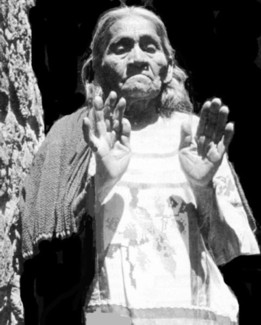 |
Fig. 27. Maria Sabina
|
María Sabina #
was the famous Mazatec curandera who kept alive the archaic practices of her ancestors the ancient Olmecs, Toltecs and Aztecs. It was Doña María Sabina who first initiated R. Gordon Wasson and Alan Richardson in the "magic mushrooms" of México. Through the writings of Wasson and Wasson (1957), Heim and Wasson (1958) and subsequent writings by others, María Sabina became world-renowned as the most famous shaman of the twentieth century. (see Allen's [1997a] volume I of Ethnomycological Journals Sacred Mushroom Studies and Estrada's [1976] autobiography of María Sabina).Bernardino de Sahagún #
was a Franciscan friar who documented the most important historical information on the use of the sacred mushrooms of the New World. It was Sahagún who first wrote down the word teonanácatl. Some other colored Spanish clergymen and historians also mentioned the sacred mushrooms in their writings--these include Juan de Córdova, Jacinto de la Serna, Diego Duran, Francisco Hernéndez, Alonzo de Molina, and Motolina (a pseudonym for Toribio de Benavente).Luc Sala #
is a German television personality involved in the media and various aspects of the European drug subculture. He is also the author of Paddos: Our Little Brothers. Starter Guide of Magic Mushroom Psychonauts. Published in the Netherlands in both English and Dutch editions.Giorgio Samorini #
is an Italian researcher of psychoactive plants and mushrooms with a special interest in the archaeology of mushroom art throughout the ages (including Amanita art and the art of the Tassilli plains). Samorini also has a special interest in the African entheogenic/aphrodisiac plant Tabernanthe iboga. Samorini is the only white person to have been initiated into the Bwiti cult of Gabon, Africa where this plant is used ceremoniously. Samorini has also studied the mycoflora of Italy.Jeremy Sandford #
is the author of In Search of the Magic Mushroom. Sandford describes his adventures in México while seeking out the magic mushrooms he had heard so much about.J. H. Sanford #
is author of an article about the accidental ingestion of psilocybian mushrooms in Japan. Some of the case studies provided by Mr. Sanford date back to the 11th century.Georges Scheibler #
is a Swiss mycologist who published the first European guide to identification of psilocybian mushrooms. After its publication Scheibler was harassed by Swiss authorities. European narcotics agents also believed that his book would lead to widespread abuse of the mushrooms in France and other European countries.Alexander and Ann Shulgin #
are chemists and authors of Pihkal: Phenlethylamines I Have Known and Loved and their new monumental work Tihkal: Tryptamines I Have Known And Loved, a book about their interest in the tryptamine compounds and the chemistry and chemical formulae of many analogues of psilocine and psilocybine.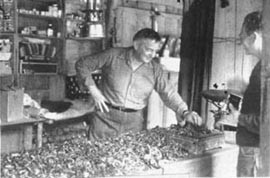 |
Fig. 28. Wasson and Singer
Oaxaca mushroom collection, circa 1953-55 |
Rolf Singer #
was a leading figure in mycology who was also a prolific writer who held important academic and research positions in Europe, North America and South America. Singer also was a Research Associate in the Department of Botany at the Field Museum of Natural History in Chicago, Illinois, from 1968-1994. Most noted for developing the nearly universally used classification for the Agaricales (mushrooms and related fungi), Singer reportedly named 86 genera, over 2460 species and infraspecies of fungi distributed in 222 genera. His 440 papers written in 9 languages, covered topics ranging from fungal systematics, nomenclature, ecology, ethnomycology, and mushroom cultivation. Singer, along with noted Michigan mycologist Alexander H. Smith, provided the academic world with the first monograph of the newly discovered species of psilocybian Psilocybes and their distribution in the Pacific Northwest of the United States and Mexico. Both of these intrepid scholars hold a special place in the ethnomycology of the sacred mushrooms of Mexico. After Roger Heim provided the taxonomy and naming of the first seven species recognized from México, the late mycologist, accompanied by two young Mexican botanists, M. A. Palacios and Gastón Guzmán, arrived in Oaxaca, México to conduct a taxonomic study on the Mexican mushrooms. Soon they met R. Gordon Wasson, and eventually followed his footsteps tracing the route of the sacred mushrooms throughout Oaxaca, Mexico. Later Singer and his colleague from the University of Michigan, Alexander H. Smith, co-authored a short monograph on the taxonomy of psilocybian mushrooms common in the Pacific Northwestern United States and México (including a few species from México). They also contributed a paper on the sacred mushrooms among the Aztecs and their Náhua descendants. Singer was the second author to note the possible medical use of the sacred mushrooms after Valentina P. Wasson by writing an excellent article on the curative properties of these mushrooms among some groups of indigenous peoples living in Oaxaca (Singer, 1957). Furthermore, Singer contributed numerous articles to books and journals regarding both the medical and recreational use of the sacred fungi. His book The Agaricales in Modern Taxonomy was the first book in modern times to discuss the idea that Teonanácatl was a mushroom, even providing some evidence linking the word Teonanácatl to certain species.Prakitsin Sihanonth #
is the head of the Department of Microbiology at Chulalongkorn University in Bangkok, Thailand. Dr. Sihanonth is considered to be a leading authority on mushroom cultivation and excels in the identification of edible, poisonous and psychoactive mushrooms of Thailand.Alexander H. Smith #
was Professor Emeritus of Botany at the University of Michigan and who along with his colleague Alexander H. Smith, published some of the earliest papers on the occurrence of psilocybian mushrooms in the United States. Smith also once wrote a paper about the hallucinations of those who study hallucinogenic mushrooms, causing several defensive responses in privately published papers between Smith, Ott and Wasson. 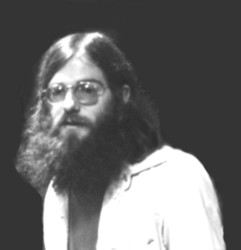 |
Fig. 29. Paul Stamets
1st International Conference on Hallucinogenic Mushrooms, 1976 Photo: Linda Dear |
Peter Stafford #
is author of the Psychedelics Encyclopedia which covers many of the entheogenic plants used as ludible drugs by certain segments of contemporary society. This has a fine chapter on the history of entheogenic mushrooms and their pandemic ascent as a popular drug. Mr. Stafford is also a regular contributor to Bruce Eisner's Island Views, a quarterly publication devoted to psychedelic drugs and their social use in . Recently Stafford published a new book Magic Grams, containing interviews of scholars involved with entheogenic drug research and/or who's interest were similar and the pages are mingled with montages and collages.Paul Stamets #
is the Paul Bunyan of mushrooms common to the Pacific Northwest United States. Stamets has been studying mushrooms in the woods of the Pacific Northwest for more than twenty years, and has discovered and co-authored four new psilocybian mushrooms: Psilocybe azurescens, P. cyanofibrillosa, P. liniformans var. americana, and P. weilii. Stamets also runs a mushroomic mail-order business, Fungi Perfecti, which grows and sells gourmet and medicinal (no psilocybian) mushrooms, and conducts in-depth workshops on edible-mushroom cultivation. Stamets has lectured on psilocybian mushrooms at numerous universities and presented seminars and slide-presentations all over the world. His books include Psilocybe Mushrooms and Their Allies [out of print], The Mushroom Cultivator co-authored by Jeff S. Chilton, Growing Gourmet and Medicinal Mushrooms, and the recent book Psilocybin Mushrooms of the World.Sam I. Stein #
was an M.D. who wrote the first medical report concerning a naegative reaction and bad trip after ingesting five dried grams of in vitro grown specimens of Psilocybe cubensis (Earle) Singer (Stein, 1958). Another important contribution was Stein's paper on the effects of Panaeolus subbalteatus and Psilocybe caerulescens in a therapeutic mode (Stein, 1959).Jay Stevens #
is author of Storming Heaven: LSD and the American Dream. Stevens devoted three chapters of this book to the sacred mushrooms. Mr. Stevens talks about the CIA involvement with the mushrooms and the controversy of the Harvard Psilocybin Projects initiated by Timothy Leary and Jonathan Clark. See related information under the headings of John Marks, Lee and Shlain.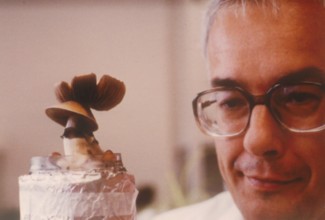 |
Fig. 30. Tjakko Stijve in his lab as
Psilocybe cubensis begins to fruit, 1983 |
Jule Stevens #
is co-author with Rich Gee of How to Identify and Grow Psilocybin [sic] Mushrooms, a field-and cultivation-guide to mushrooms of the Pacific Northwest United States and Hawai'i. This guide has step-by-step photographs of the process involved in producing good strains of Psilocybe cubensis.Tjakko Stijve #
was born in Utrecht (Netherlands) where he recieved an education in analytical chemistry. Since 1967 he has lived in Switzerland, where (until his retirement in 1999) he ran a section on food contaminants in the Quality Assurance Department of Nestle. Early on he developed an interest in the chemistry of higher fungi, resulting in the publication of many papers on mushroomic toxins and on the bioaccumulation of potentially-toxic trace-elements in macromycetes. While studying tryptophan-derivatives in the early 1980's, he came upon the tryptamines bufotenine, psilocine and psilocybine in some fungi. This awakened his curiosity about psychoactive mushrooms, and prompted him to look for the tryptamines in (at that time) unexplored genera such as Inocybe and Pluteus. In the early 1990's together with mycologist André de Meijer, he made an inventory of the psychoactive mushrooms occurring in Paraná, a province in Southern Brazil. He is presently involved in a study on selenium and bioactive compounds in the genus Albatrellus, which will mark the end of his professional activities in mycochemistry. After his retirement, Stijve will explore a number of ethnomycological subjects.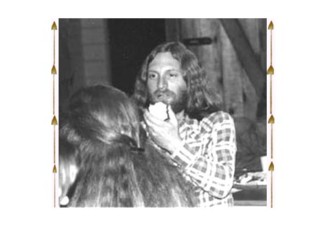 |
Fig. 31. David Tatelman 1st International Conference
on Hallucinogenic Mushrooms, 1976 Photo: Linda Dear |
Frederick Swain #
was a student who traveled to México in the early 1960's and was graciously greeted by María Sabina who performed a mushroom ceremony for him. Swain wrote of his experience in the Journal Tomorrow, later reprinted in Psychedelic Review No. 2.David Tatelman #
is President and founder of the Homestead Book Company. By selling thousands of Mushroom kits and spores over a period of 25 years, he is directly responsible for most of the psilocybe mushrooms now cultivated in the United States. He also published one of the first field guides, The Magickal Mushroom Handbook and was the publisher of Paul Stamets' first book, Psilocybin Mushrooms and Their Allies. His genius has been in popularizing mushrooms to the masses.Peter Vuchich #
of Hongero Press was the first person to commercially sell Psilocybe cubensis spores, which he did by including them in his early book about cultivating mushrooms in the early 70's. Vuchich was also the first person in the United States to successfully advertise his products in High Times magazine selling spore kits to the general public.Johanna Wagner #
was a German ethnologist (1923-1990) who became a practicing medicine-woman (mganga) in Africa. In 1982, Dr. Wagner participated in a scientific experiment where she bioassayed fresh caps of the fly agaric. Her experiences with the fly agaric-man during an experience covering almost three days and nights, was recorded on tape and eventually published in Ein Füllhorn göttlicher Kraft. Unter Schamanen, Gesundbetern und Wetterbeschwörern (Berlin, 1985).R. Gordon and Valentina Wasson #
were pioneer researchers of the entheogenic mushrooms and they are also the main reason we are all here reading this manuscript. Together they coined the terms mycophobia and mycophilia. R. Gordon Wasson is also referred to as the Father of Ethnomycology. Wasson and his wife Valentina are the epitome of the heart of sacred mushrooms. In the middle 1950's, they became the first outsiders to partake of the sacred mushrooms. Gordon Wasson also studied the Aryan entheogen soma; the Kuma aborigines of New Guinea who used theragenic Boletus and Russula species, and extensively researched the use of Amanita muscaria among certain of Siberia. Later, he brought to the attention of the public and academic communities the discovery of a North American tribe which uses Amanita muscaria in a religious context [Wasson & Wasson, 1957; Wasson, 1957a, Wasson, 1958b, Wasson, 1979, jpd on Ojibway].Roy Watling #
is an English mycologist, the Senior Principal Scientific Officer of the Royal Botanic Garden in Edinburgh, Scotland. Watling has contributed numerous articles on the taxonomy and use of psilocybian mushrooms from Australia and Great Britain and has published papers with Gastón Guzmán.Andrew Weil #
is a recipient of an AB degree in botany from Harvard University and also worked for the National Institute of Mental Health. Currently, Dr. Weil is the director of the Program in Integrative Medicine and clinical professor of internal medicine at the University of Arizona in Tucson. As a fellow of the Institute of Current World Affairs, Weil traveled extensively in Mexico, Central and South America gathering information about medicinal plants and healing.Weil was the first investigator to report on the ludible use of psilocybian mushrooms from the Pacific Northwest United States, Colombia in South America and México. He is a graduate of Harvard Medical School who has traveled extensively writing on drug-use throughout México, Central and South America. Weil is author of The Natural Mind, The Marriage of the Sun and the Moon, From Chocolate to Morphine, and numerous books on holistic health and healing. It was Weil who first reported on the ludible use of Psilocybe semilanceata (the 'liberty-cap' mushroom) in Oregon. Weil has also contributed several papers on psilocybian mushrooms to The Harvard Review, The Crimson (Harvard's newspaper), The Botanical Museum Leaflets of Harvard, The Journal of Psychedelic Drugs, The Journal of Altered States of Consciousness and Look Magazine.
Arnold Wolman #
is author of a small pamphlet on Psilocybe cubensis. This 16-page booklet described the collection of P. cubensis from the southeastern United States. This guide was published in Chicago, Illinois and was somewhat limited in its distribution.Anthony Young #
is a mycologist from Australia who has studied extensively the Genus Panaeolus in Australia. He has also published a review of the genus Panaeolus from Australia.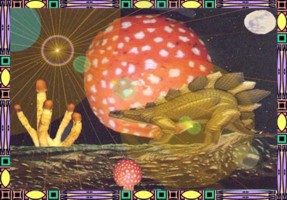 |
Image 8: Red Dwarf. Graphic Design by John W. Allen
|
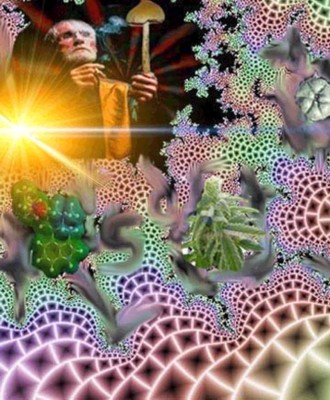 |
Image 9: In Memory of Timothy Francis Leary
|



